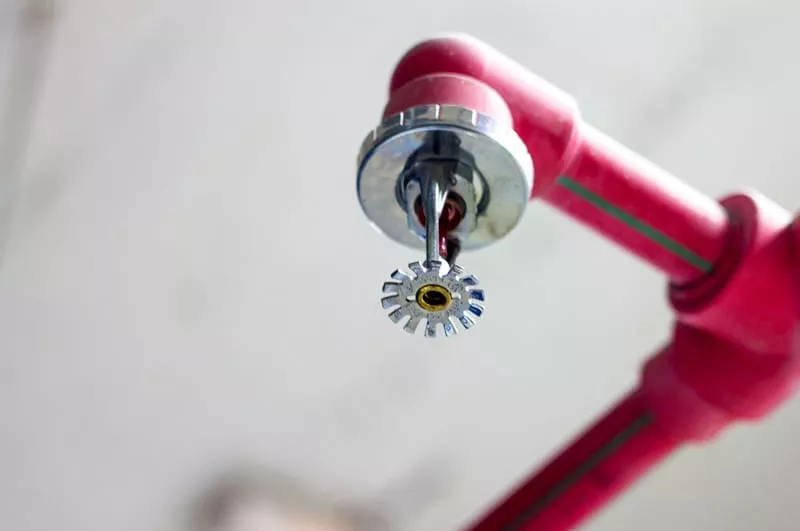
Fast-response sprinklers are becoming the standard in commercial fire protection, and for good reason. Whether you’re designing an office, school, retail center, or warehouse, ensuring quick response during a fire is critical to minimizing damage and saving lives.
These advanced systems activate faster than traditional sprinklers, helping to suppress fires at their earliest stages. In this article, we’ll explain what makes fast-response sprinklers different, where they work best, and how they support smarter, code-compliant building design.
What Are Fast-Response Sprinklers?
Fast-response sprinklers, also called Quick Response (QR) or Early Suppression Fast Response (ESFR) sprinklers, are built to activate faster in the presence of heat. Unlike standard sprinklers, which operate at higher Response Time Indexes (RTIs), fast-response models detect heat sooner and begin discharging water before a fire spreads.
Their quicker activation is made possible by a smaller, more sensitive thermal element—typically a thin glass bulb or metal link.
Key Benefits of Fast-Response Sprinklers in Commercial Buildings
1. How Do Fast-Response Sprinklers Improve Occupant Safety?
Every second matters in an emergency. These sprinklers buy valuable time for people to evacuate safely, especially in high-traffic spaces like schools, offices, and retail centers. Their use is also common in warehouse fire sprinkler system design, where rapid suppression is essential to protect both employees and inventory.
2. How Can They Reduce Property Damage?
Because fast-response systems react early, they often confine the fire to a smaller area, reducing damage to equipment, furnishings, and building materials.
3. Can They Help With Fire Code Compliance?
Yes. Many jurisdictions recommend or require fast-response sprinklers in certain occupancies. Using them can simplify compliance and permit approvals, especially for buildings with limited egress options or high occupant density.
4. Do Fast-Response Sprinklers Lower Installation Costs?
In some designs, fewer sprinkler heads are needed to provide the same coverage, and smaller pipe sizes can be used, leading to cost savings in materials, labor, and long-term maintenance.
Where Are Fast-Response Sprinklers Most Effective?
Fast-response sprinklers are best suited for:
- Office buildings: Reduce visual clutter while enhancing safety.
- Retail centers: Safeguard merchandise and protect shoppers.
- Healthcare facilities: Allow rapid containment, minimizing risk to vulnerable individuals.
- Schools and universities: Fast action in dense, occupied areas like classrooms or auditoriums.
- Light-to-medium hazard storage facilities: Provide early suppression for more predictable fire loads.
Fast-Response vs. Standard-Response: What’s the Difference?
The key difference between fast-response and standard-response sprinklers lies in their activation speed and primary purpose. Fast-response sprinklers are designed with a lower Response Time Index (RTI), meaning they activate more quickly when exposed to heat. This faster reaction time makes them ideal for protecting human life by containing fires early and allowing more time for safe evacuation. They’re most commonly used in environments focused on life safety, such as offices, schools, healthcare facilities, and retail spaces.
Standard-response sprinklers, on the other hand, activate more slowly due to their higher RTI and are primarily intended to protect property and structural components. These are typically used in industrial or warehouse settings where occupant evacuation is less of a concern and the focus is on containing fire to prevent structural collapse or equipment loss.
In short, fast-response systems are preferred where people are the priority, while standard-response systems are used where protecting property is the main goal.
How Are Fast-Response Sprinklers Integrated into Modern Systems?
At companies like Guardian South Inc., fast-response sprinkler systems or guardian fire protection systems are often integrated into custom fire protection designs tailored to the specific needs of each building. Using advanced 3D CAD modeling, Guardian South ensures that sprinkler systems coordinate perfectly with lighting, HVAC, racking systems, and architectural features, eliminating conflicts and optimizing both safety and aesthetics.
In some commercial interiors, especially those with high ceilings or open layouts, Extended Coverage Quick Response (ECQR) heads may be used to provide larger coverage with fewer sprinklers, cutting costs while improving efficiency.
Planning Ahead: Why It’s a Smart Investment
Modern commercial spaces demand more than basic safety; they require systems that align with energy efficiency, multi-use design, and evolving building codes. Fast-response sprinklers check all the boxes. Whether you’re building a new facility or upgrading an older facility, these systems offer a future-ready solution that enhances safety and compliance.
Frequently Asked Questions
Q1: Are fast-response sprinklers more expensive than standard ones?
While the unit cost may be slightly higher, overall installation and maintenance expenses can be lower due to reduced headcount and smaller pipe sizes.
Q2: Are they suitable for warehouses?
Yes, for light and medium hazard storage. For high-piled storage or heavy industrial use, ESFR or standard-response systems may be more appropriate.
Q3: Do they require more maintenance?
No. Maintenance follows the same NFPA guidelines as standard systems, including regular inspections and functional testing.
Q4: How do I know if my building qualifies?
A fire protection engineer or consultant like Guardian South Inc. can evaluate your layout, ceiling height, and occupancy type to recommend the right system.
Q5: Are these systems allowed by local fire departments?
Yes, when designed by licensed professionals and submitted through proper permitting. Their life-safety benefits can even streamline approvals.
Final Thoughts
Fast-response sprinkler systems are more than just a fire protection feature; they’re a strategic investment in life safety, code compliance, and cost efficiency. By responding quickly and effectively, they help protect people, property, and peace of mind in today’s complex commercial interiors.
For a tailored fire protection solution, work with experts like Guardian South Inc., who understand how to maximize the performance and value of fast-response systems in your space.

